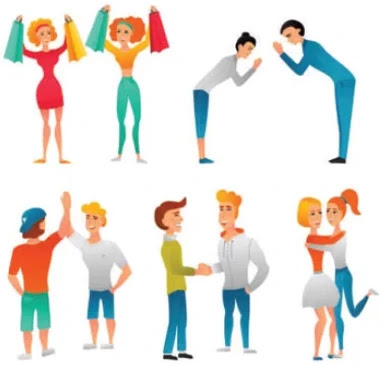Non-Verbal Communication | CBSE Class 10 IT (402)
Non-verbal communication is the expression or exchange of information or messages without using any spoken or written word.
In other words, we send signals and messages to others, through expressions, gestures, postures, touch, space, eye contact, and paralanguage.
Importance of Non-verbal Communication
In our day-to-day communication,
55% of communication is done using body movements, face, arms, etc.
38% of communication is done using voice, tone pauses, etc.
7% of communication is done using words.
Types of Non-verbal Communication
1. Facial Expressions
2. Posture
3. Gestures or Body Language
4. Touch
5. Space
6. Eye Contact
7. Paralanguage
1. Facial Expressions
Our expressions can show different feelings, such as Happiness, Sadness, Anger, Surprise, Fear, etc.
2. Posture
Postures show our confidence and feelings. For example, a straight body posture shows confidence while a slumped posture is a sign of weakness.
3. Gestures or Body Language
Gestures include body movements that express an idea or meaning. For example, raising a hand in class to ask a question and biting nails when nervous.
4. Touch
We communicate a great deal through touch. For example, a firm handshake to display confidence and a pat on the back to encourage someone.
5. Space
Space is the physical distance between two people. The space between two persons while communicating generally depends on the intimacy or closeness between them.
6. Eye Contact
The way we look at someone can communicate a lot. Eye contact shows that we are paying attention to the person as opposed to looking away, which can make the other person feel ignored.
7. Paralanguage
How we speak affects our communication and includes the tone, speed, and volume of our v6ice. For example, talking fast may show happiness, excitement, or nervousness while speaking slowly may show seriousness or sadness.
Advantages of Non-Verbal Communication
- Non-verbal cues complement a verbal message by adding to its meaning. You can pat someone you offended at the back as you say sorry to him or her.
- Information can be easily presented in non-verbal communication by using visual, audio-visual, and silent means of non-verbal communication.
- The non-verbal message may substitute for the verbal message especially if it is blocked by noise, interruption, long-distance, etc. for example gestures-finger to lips to indicate the need for quiet, facial expressions- a nod instead of a yes.
- Often used to accent a verbal message. The verbal tone indicates the actual meaning of specific words.
- Used to repeat the verbal message (e.g. point in a direction while stating directions.)
- This type of communication use gestures, facial expressions, eye contact, proximity, touching, etc., and without using any spoken or written word. So, it is very much helpful for illiterate people.
Disadvantages of Non-Verbal Communication
- Non-verbal communication is quite vague and imprecise. Since in this communication, there is no use of words or language which expresses clear meaning to the receiver. No dictionary can accurately classify them. Their meaning varies not only by culture and context but by the degree of intention.
- It is possible to stop talking in verbal communication, but it is generally not possible to stop nonverbal cues. Also, spoken language has a structure that makes it easier to tell when a subject has changed, for instance, or to analyze its grammar. Nonverbal does not lend itself to this kind of analysis.
- While watching someone’s eyes, you may miss something significant in a hand gesture. Everything is happening at once and therefore it may be confusing to try to keep up with everything. Most of us simply do not do so, at least not consciously.
- In non-verbal communication, long conversation and necessary explanations are not possible. No party can discuss the particular issues of the messages.
Mastering Non-Verbal Communication
- Smile when you meet someone.
- Keep your face relaxed.
- Match your expressions with your words.
- Nod while listening.
- Keep your shoulders straight and body relaxed.
- Sit straight while resting your hands and feet in a relaxed position.
- While standing, keep your hands by your sides.
- Keep your hands open.
- Avoid pointing your finger at people.
- Tilt your head a bit to show that you are attentive.
- Shake hands firmly while meeting someone.
- Avoid other touch gestures during formal communication.
- Maintain proper space depending on the relationship, which could be formal or informal, or the closeness with the person with whom you are talking.
- Look directly at the person who is speaking.
- Avoid staring; keep a relaxed look.
- Maintain eye contact with intermittent breaks.
- Use a suitable tone and volume.
- Maintain a moderate speed while talking.

